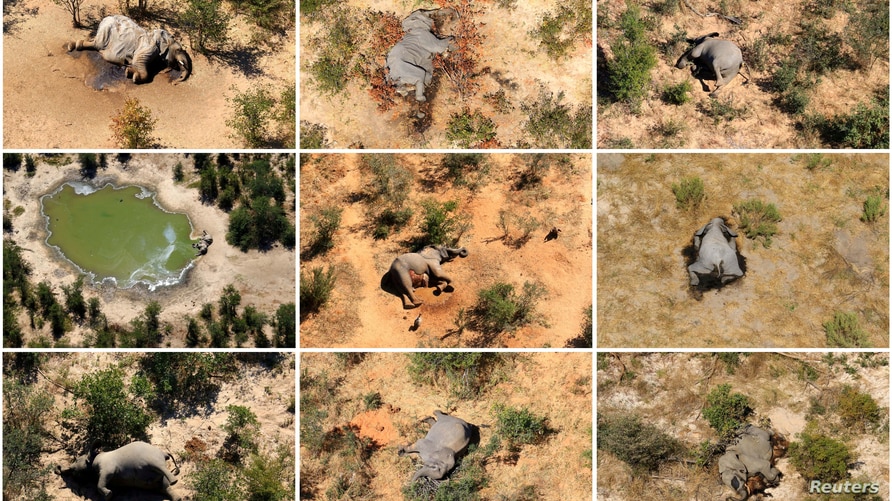Parks authorities in Zimbabwe say a bacterial disease is behind the deaths of dozens of elephants as an infection spread from Asia and in other parts of southern Africa.
Fulton Mangwanya, the director-general of the Zimbabwe Parks and Wildlife Management Authority, told a parliamentary committee this week that 34 elephants have died so far and “many” more could still die “in the short term.”
“All results to date point to the cause of these elephant deaths being a disease known as hemorrhagic septicemia,” said Mangwanya, noting that the disease does not appear to have been previously recorded as causing deaths among Africa’s savannah elephants.
“However, it has been reported to kill Asian elephants in India. It has also affected cattle, pigs and chickens in southern Africa in which it can cause massive mortality. It has also been recognized in buffalo and some other wildlife species in this part of this world,” he said.
He said the disease “may have been around in elephants in this region for some time,” pointing to specimens from two dead elephants from the vast Hwange National Park in 2019 that showed “the same microscopic pathology,” although a definitive diagnosis could not be made at that time.

Most of the elephants that died recently in the Pandamasue Forest, located between Hwange National Park and Victoria Falls, were weak or young, mostly under 15 years old.
The dead elephants were found with their tusks still on their bodies, ruling out poaching. In recent years poachers in Zimbabwe have poisoned dozens of elephants with cyanide and then have taken their ivory tusks to sell them to illegal traders.
The parks authorities also said toxic water was an unlikely cause because the country has been pumping “clean water” from wells during this dry season.
To eliminate other causes, blood samples have been sent to the United Kingdom, while other samples will be sent to the United States and neighbouring South Africa for further testing, said Mangwanya.
Not enough information is known about the disease’s effect on local elephants to predict a long-term outcome, he said.
“It is unlikely that this disease alone will have any serious overall impact” on the survival of the southern African country’s booming elephant population, said Mangwanya.
“Yes, they die, but honestly this is just nothing, a drop in the ocean because we have over 84,000 elephants in Zimbabwe, which is overpopulation already,” he said. “But this is a disease that we should work seriously to make sure that we unearth and identify properly so that corrective measures are taken.”
In neighbouring Botswana, home to the world’s largest population of the pachyderms, the government last week said the sudden deaths of some 330 elephants in the northwestern region of the country earlier this year may have occurred because they drank water contaminated by toxic blue-green algae.
Mangwanya said the recent elephant deaths in Zimbabwe also showed that the animals experienced “extremely sudden death,” and that Botswana might need to conduct tests to find out if it’s not the same bacterial infection being experienced in Zimbabwe.
Botswana says a string of mysterious elephant deaths has come to a halt since June, after at least 281 carcasses were found.
Experts in the southern African country, with the world’s largest elephant population, said there were no signs of poaching or predators. Most of the blood samples sent abroad for testing indicate a toxin caused the deaths.
However, it is not clear if the toxin is man-made or natural, says Botswana’s Ministry of Wildlife and Environment Permanent Secretary Oduetse Koboto.
“We have received most of the results. A lot of variables that we suspected had tested negative. We ruled out any virus, no bacteria. Pathogens (are) also negative,” he said. “The only thing that we are waiting for is toxicology. What is evident is that we are now dealing with a poison.”
Koboto says they are waiting on one last batch of test results from the United States before reaching a conclusion.
Veterinarian Dr. Mbatshi Mazwinduma says a naturally occurring toxin would explain why no more elephants appear to be dying in Botswana’s Okavango panhandle.
“In the period leading to June, remember this is a dry period, the amount of water is in low quantities. If it is because of a naturally occurring toxin, they would be in high concentration in the waters and those elephants that drink in particular spots get affected. With the rising waters of the Okavango in the last couple of weeks, the toxins are diluted and then washed out,” Mazwinduma said.
Conservationist Neil Fitt agrees that changes in weather conditions could have diluted a natural toxin.
“If it is an environmental toxin, they come and go depending on weather conditions,” he said. “Obviously, the conditions, if that’s the case, have now changed and that’s the reason why the deaths have stopped, which is a good thing. But until we get the results, which are extremely long in coming, we cannot say much more.”
Koboto says getting quick results on the investigations and test samples was not possible due to COVID-19 restrictions.
“There were lockdowns everywhere, even internationally,” he said. “Mostly, we are dependent on air transport. If there are no flights going outside the country even (to) South Africa here, how could we have taken them (samples) out?”
The first mysterious death in Zimbabwe occurred Sept 1.
The two countries have the world’s combined largest elephant population at more than 200,000 animals – most of them in Botswana.
Conservationists estimate the number of wild, African elephants has dropped by almost a third in the last decade due to drought, loss of habitat, and poaching.
Officials in Botswana were initially at a loss to explain the elephant deaths there but have since blamed toxins produced by another type of bacterium.




